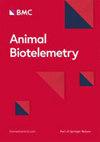一份案例报告,评估用于监测陆生哺乳动物运动的低成本跟踪GPS装置的效用
IF 2.5
3区 环境科学与生态学
Q2 BIODIVERSITY CONSERVATION
引用次数: 0
摘要
动物运动的准确数据可以突出行为和生态问题,如领土相互作用、迁移模式障碍(包括运动走廊受损)或避免栖息地恶化以及疾病传播,从而有助于保护决策。本研究考察了momomovement全球定位系统(GPS)标签的效用,这是一种低成本的牛耳标签跟踪设备,用于监测南澳大利亚陆地哺乳动物种群的运动。结果40个固定标签用于水平精度测试,平均定位误差为33.26 m (IQR = 16.9 ~ 59.4),最大记录误差为410 m。定位精度受水平精度稀释(HDOP)(卫星可用性和几何形状的度量)和头顶冠层覆盖度的影响较弱。大量标签产生不频繁和不一致的读数,平均每天12条记录(IQR = 6-12),与标签与中心位置的LoRa天线的距离负相关;然而,有些标签每天记录的位置少于一个。我们提出,momovement标签不足的主要原因是仅使用GPS卫星星座(USA, 1978),与全球导航卫星系统(GNSS)中可用的多个星座不同,GPS卫星星座无法在- 35°纬度的天空中提供足够的卫星数量或几何形状覆盖,无法在24小时内定期计算精确位置。我们得出的结论是,GPS标签不适合需要高定位精度或识别个人社会互动的研究,因为GPS星座在长时间内可用的卫星数量有限。然而,它们可以被用来提供对家庭范围大小的估计,或者在更靠近赤道的地区追踪动物的大规模日常活动。本文章由计算机程序翻译,如有差异,请以英文原文为准。
A case report assessing the utility of a low-cost tracking GPS device for monitoring terrestrial mammal movements
Abstract Background Accurate data on animal movements can highlight behavioural and ecological issues, such as territorial interactions, barriers to migration patterns, including compromised movement corridors, or avoidance of deteriorating habitats, and disease transmission, thus helping in conservation decision making. This study examines the utility of mOOvement global positioning system (GPS) tags, a low-cost cattle ear tag tracking device to monitor movements of terrestrial mammal populations in South Australia. Results Stationary tags ( n = 40) were used to test horizontal accuracy with a median location error of 33.26 m ( IQR = 16.9–59.4), and maximum recorded error of 410 m. The locational accuracy was weakly influenced by the horizontal dilution of precision (HDOP), a measure of satellite availability and geometry, and overhead canopy cover. Numerous tags produced infrequent and inconsistent readings, median of 12 records per day ( IQR = 6–12), correlating negatively with the tag’s distance from the centrally located LoRa antenna; however, some tags recorded fewer than one position per day. Conclusions We propose that the primary cause of mOOvement tag inadequacy is the use of only the GPS satellite constellation (USA, 1978), which does not provide adequate coverage in either satellite number or geometry in the sky at the − 35° latitude to calculate accurate positions regularly over 24 h, unlike the multiple constellations available in the global navigation satellite system (GNSS). We conclude that GPS tags are unsuitable for studies requiring high locational accuracy or identification of an individual’s social interactions, where the GPS constellation has a limited number of satellites available during prolonged periods. They can, however, be used to provide estimates of home range size or track large scale daily movements of animals in more equatorially located regions.
求助全文
通过发布文献求助,成功后即可免费获取论文全文。
去求助
来源期刊

Animal Biotelemetry
Agricultural and Biological Sciences-Animal Science and Zoology
CiteScore
4.20
自引率
11.10%
发文量
33
审稿时长
10 weeks
期刊介绍:
Animal Biotelemetry is an open access peer-reviewed journal that publishes the results of studies utilizing telemetric techniques (including biologgers) to understand physiological, behavioural, and ecological mechanisms in a broad range of environments (e.g. terrestrial, freshwater and marine) and taxa. The journal also welcomes descriptions and validations of newly developed tagging techniques and tracking technologies, as well as methods for analyzing telemetric data.
 求助内容:
求助内容: 应助结果提醒方式:
应助结果提醒方式:


